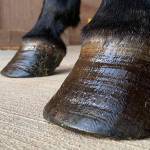Role of Nitric Oxide, Endothelial Dysfunction, and Blood Pressure in Laminitis Explored

Laminitis is always a concern for horse owners, and that concern is increasing with the rise of endocrinopathies diagnosed in horses. Specifically, horses with metabolic conditions such as equine metabolic syndrome and pituitary pars intermedia dysfunction have a higher risk of developing life-threatening laminitis than healthy horses. According to a recent study, dysfunction of the lining of the blood vessels—the endothelium—both within the foot and throughout the horse’s body may contribute to the development of laminitis.*
“Underlying endothelial dysfunction may place the animal closer to the threshold of clinical disease, requiring a lesser insult, in the form of ingested pasture, to induce endocrinopathic laminitis,” shared that research team.
When healthy, the endothelium helps maintain blood vessels in a relaxed, dilated state. Nitric oxide (NO) is a key mediator involved in smooth muscle relaxation and vasodilation.
“With endothelial dysfunction, NO levels decrease and the blood vessels constrict. With that constriction, systemic blood pressure can increase,” explained Kathleen Crandell, Ph.D., a nutritionist for Kentucky Equine Research.
Thus, measuring circulating NO levels in a horse’s body could yield valuable information regarding endothelial function, which in turn may play a role in the development of laminitis.
NO levels were therefore measured in five ponies with and five ponies without a history of laminitis. To be included in the laminitic group, ponies each had two episodes of endocrinopathic laminitis a minimum of 12 months prior to the study. An intravenous catheter was placed in each pony for the duration of the study. Circulating NO levels and blood pressure were measured before and after the NO synthase blocker L-NAME was administered.
As expected, inhibition of NO synthesis by L-NAME resulted in reduced NO levels and increased blood pressure in all ponies. This finding was expected because NO normally keeps blood vessels dilated. With lower circulating NO levels, blood vessels were expected to constrict, increasing systemic blood pressure.
Unexpectedly, the change in blood pressure after administering the NO synthase inhibitor L-NAME differed between the two groups. Specifically, ponies with a previous history of laminitis had a greater increase in blood pressure than ponies without a history of laminitis.
“This was the opposite of what the research team anticipated. The researchers hypothesized that if NO levels were already low in ponies with previous episodes of laminitis, then the ponies would already have a higher blood pressure than nonlaminitic ponies. Thus, further inhibition of NO production would not cause any additional increase in blood pressure. Instead, blood pressure increased more in the ponies with a history of laminitis and presumptive endothelial dysfunction than healthy ponies,” Crandell explained.
Faced with these data, the researchers suggested that ponies with a history of laminitis may have a greater blood pressure response to NO as a result of their blood vessels being more sensitive to NO than ponies without a history of laminitis.
“More research on NO, endothelial dysfunction, and blood pressure is warranted because it may lead to a better understanding of how to diagnose and treat laminitic animals as well as identifying susceptible animals before they develop laminitis,” Crandell suggested.
While the exact mechanisms involved in endocrinopathic laminitis continue to be studied, experts do know that horses and ponies with endocrinopathies require different, more intensive management than healthy animals.
According to Crandell, feeding animals predisposed to laminitis requires careful selection of feedstuffs lower in starch and sugar, vigilance of pasture intake, and control of body condition.
“To increase the health of the laminitic damaged hoof, supplement with biotin, zinc, and essential fatty acids found in well-formulated hoof supplements like Bio-Bloom PS,” advised Crandell. Look for Bio-Bloom HF in Australia.
*Finding, E.J.T., J. Elliott, P.A. Harris, and N.J. Menzies-Gow. 2022. Nitric oxide synthase inhibition reveals differences in the nitric oxide pathway in previously laminitic ponies. Research in Veterinary Science 150:79-82.








